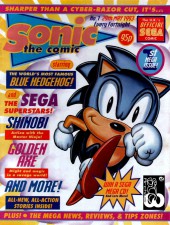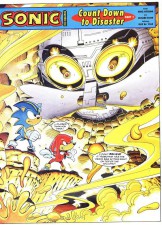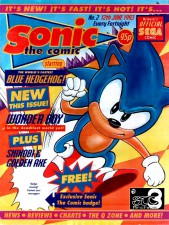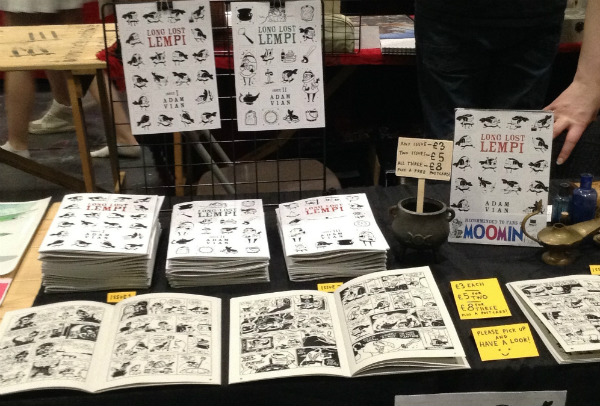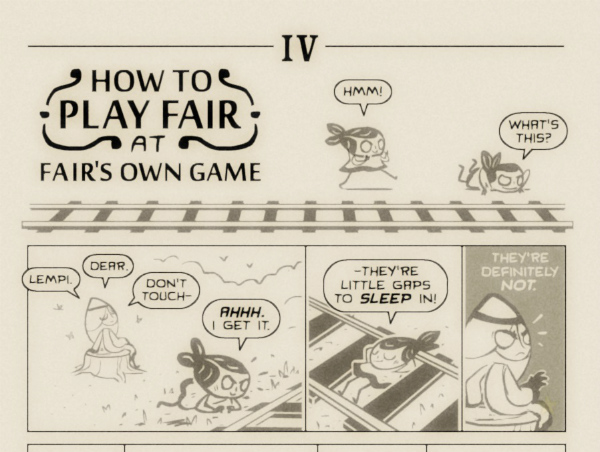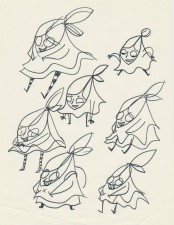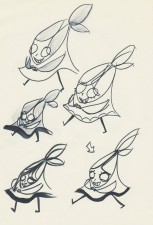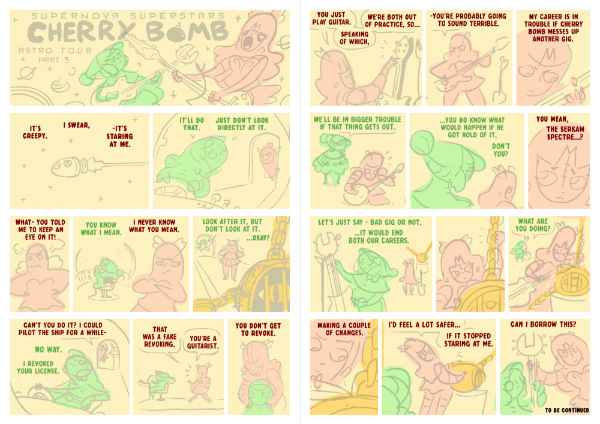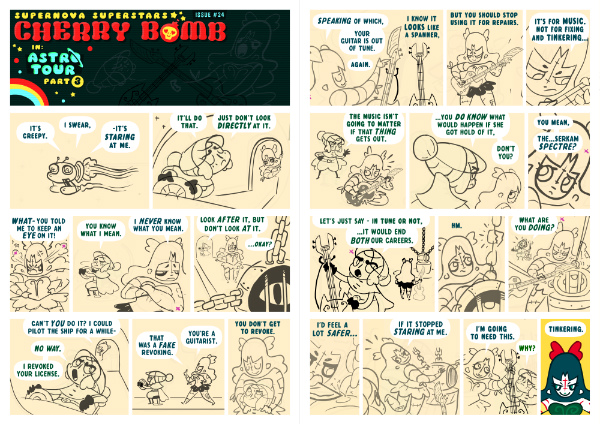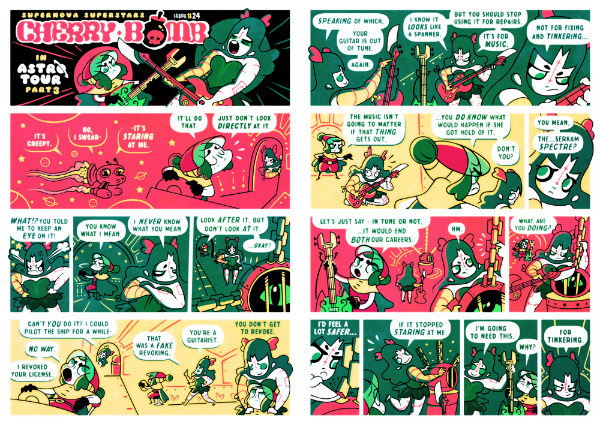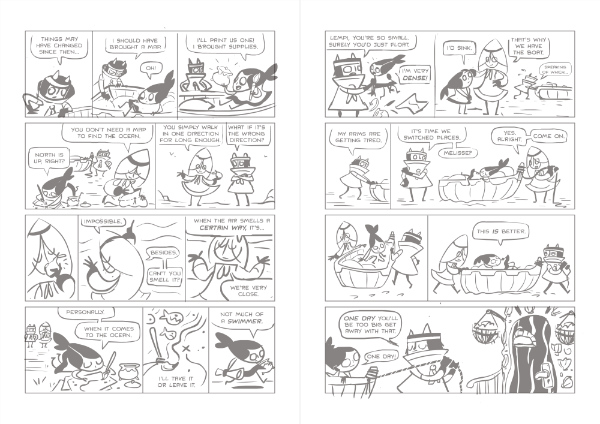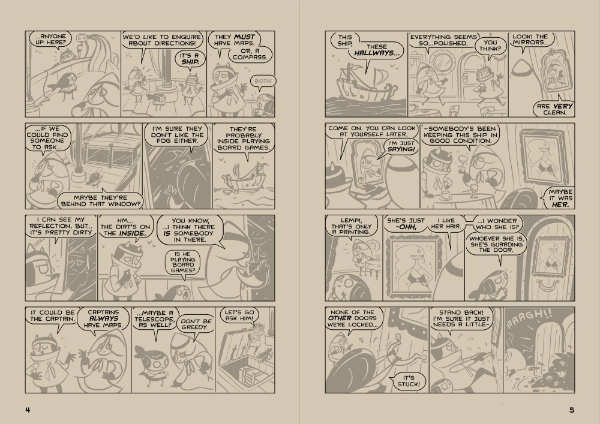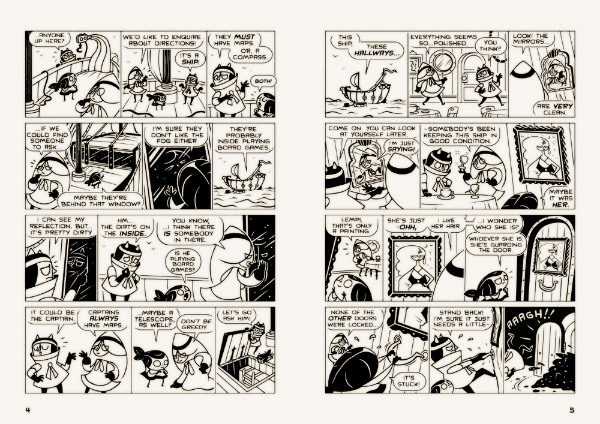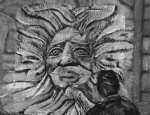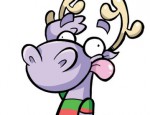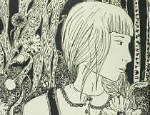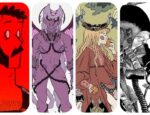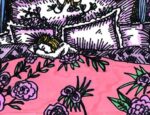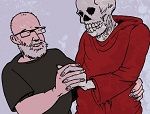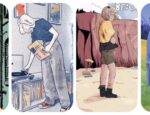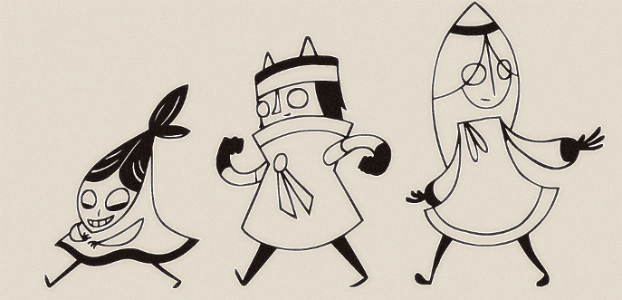 Adam Vian is the man behind the delightful all-ages fantasy Long Lost Lempi, a series that I first covered here in ‘Small Pressganged’ back in 2013. I described the comic then as “feelgood escapism that will make the world seem a little brighter on finishing it than it did when you started reading” and I also included the most recent Lempi adventures as part of my annual ‘Ten UK Small Press Comics You Need to Own!’ round-up for 2014.
Adam Vian is the man behind the delightful all-ages fantasy Long Lost Lempi, a series that I first covered here in ‘Small Pressganged’ back in 2013. I described the comic then as “feelgood escapism that will make the world seem a little brighter on finishing it than it did when you started reading” and I also included the most recent Lempi adventures as part of my annual ‘Ten UK Small Press Comics You Need to Own!’ round-up for 2014.
The fourth of my ‘Six UK Small Press Creators to Watch in 2015’ to be interviewed this year, Adam Vian is a gent with one foot in both the worlds of comics and gaming. Today I chat with him about the whimsical world of Lempi, the inspirations for his work and appealing to a rather unique target demographic…
ANDY OLIVER: Have comics always played a major role in your life? What was your entry point to the form?
ADAM VIAN: The most significant thing for me by far was the Fleetway published Sonic the Comic (above) from 1993 onwards – growing up playing video games with my brother Tom on our Sega Mega Drive, Sonic the Hedgehog was something of an obsession for my young self. Sonic the Comic had the perfect tone for young readers who are bored of The Beano but not old enough for Batman – it was adventurous and fun but also tackled “serious” long-form stories with truly threatening villains.
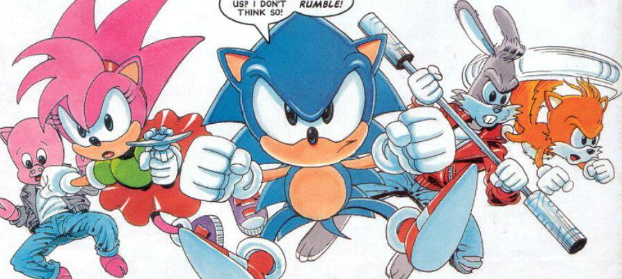 My art style as a kid was definitely informed by a childish attempt to copy the chunky cartoon form of Richard Elson (above and centre image), one of the lead artists. I remember copying a lot of drawings from the comics, so it was about the most direct influence I can imagine. In general I think my love affair with Sonic the Comic is what cemented the “I want to draw characters” feeling for the rest of my life! Thanks for that, Nigel Kitching & co.
My art style as a kid was definitely informed by a childish attempt to copy the chunky cartoon form of Richard Elson (above and centre image), one of the lead artists. I remember copying a lot of drawings from the comics, so it was about the most direct influence I can imagine. In general I think my love affair with Sonic the Comic is what cemented the “I want to draw characters” feeling for the rest of my life! Thanks for that, Nigel Kitching & co.
Long Lost Lempi is your most recognisable comics work to date. For the uninitiated could you give us a brief rundown of the book’s premise, tone and the issues to date?
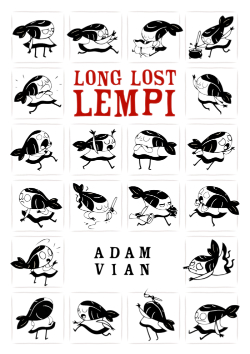 Long Lost Lempi is about three friends travelling together on some kind of journey, and in each issue they get tangled up in a little mess.
Long Lost Lempi is about three friends travelling together on some kind of journey, and in each issue they get tangled up in a little mess.
Lempi herself is the title character, she’s an energetic girl with a head that resembles a fish, or more specifically – shrimp sushi. She travels with her friend Melisse, a tall girl with a cool head and a polite tone who is something of an older sister for Lempi. The last member of the group is Ermin, an impatient boy who finds himself divided between childish arguments with Lempi and grown-up conversation with Melisse.
Sometimes I describe the comics as “Fairytale-like” (and the stories do feature mermaids, genies and so on) but really I try to go for a down-to-earth tone. The idea being to contrast fairytale scenarios with a touch of reality, particularly in how the three main characters react to things going on around them. I like to think of it as what would happen if you went on a magical adventure, but spent the entire time calmly chatting with your best friends about it.
In the first issue, Lempi and friends are dragging a rowing boat through the desert, looking for the ocean, but it’s gone missing. They end up getting help from a reluctant local mermaid, and Lempi receives her trademark cauldron at the end. I like the first issue because it has a nice meandering story with a relaxed tone that I haven’t managed to recapture as of yet.
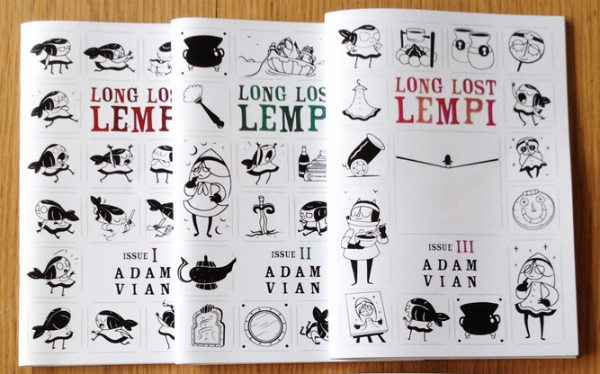 In the second issue, Lempi and friends climb aboard a pirate ship and end up getting bullied by the captain – a villainous genie with a fondness for banishing people into common objects. Issue 2 has a couple of nice visual jokes, including some twisted logic about wishing yourself out of a magic lamp, and a sequence in which Lempi and Ermin unsuccessfully describe Melisse’s appearance to a new friend.
In the second issue, Lempi and friends climb aboard a pirate ship and end up getting bullied by the captain – a villainous genie with a fondness for banishing people into common objects. Issue 2 has a couple of nice visual jokes, including some twisted logic about wishing yourself out of a magic lamp, and a sequence in which Lempi and Ermin unsuccessfully describe Melisse’s appearance to a new friend.
The third issue mostly takes place in an underwater circus. Melisse gets taken in by a ruthless ringleader named Miss Miracle, and is made to perform as the star acrobat. Ermin drifts off to find help, while Lempi becomes Melisse’s biggest fan and starts making her own merchandise to share with the locals. I decided to split up the three main characters for most of this issue which was a risk, I’m not sure how well it works – this story is probably my least favourite, but I like the ending so it balances out.
How would you define your target audience for Long Lost Lempi? Were you consciously aiming at an all-ages readership?
I was aiming at an all-Adam readership. It might be a cliché for an artist to say “I make stuff that I would like to read” but that’s it. Once I’d finished the first issue I began thinking about who else would actually like to read it.
On the surface it seems like a children’s comic, light-hearted adventures with fun characters and stuff. And it is! And that’s great! -the one thing is, I feel like the humour is sometimes built around defying expectations and twisting clichés slightly.
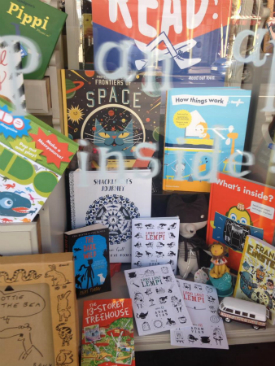 One example of this would be when Lempi screams in fear at meeting the genie, but then immediately calms down while she tries to remember if she’s actually scared of genies or not. This particular aspect of the writing is probably better for an older reader who has an established set of expectations in their head already. Maybe I’m reading too much into it.
One example of this would be when Lempi screams in fear at meeting the genie, but then immediately calms down while she tries to remember if she’s actually scared of genies or not. This particular aspect of the writing is probably better for an older reader who has an established set of expectations in their head already. Maybe I’m reading too much into it.
Either way I feel like I have definitely ended up with an all-ages readership, which is lovely!
Following up on that then, how much feedback have you had from younger readers about the book?
I meet younger readers at comic events and they seem to really enjoy the comic. When someone comes back to buy the next issue it’s the best feeling in the world! I’m so grateful for every single person who has ever come up to my table to buy a comic or tell me they liked it.
In general though I feel like I do struggle to get specific feedback out of people, in terms of which issues/scenes/characters/jokes they liked or disliked. That stuff is always valuable!
Are there any teasers you can give us to what’s in store for Lempi and pals in issue #4?
Issue #4 is currently named “How to Play Fair at Fair’s Own Game”. It’s about a group of snobbish, elitist Fairies who live in a train in the middle of a forest and play a peculiar card game with slightly abstract rules. Lempi has to enter the card game tournament to save the day! Sort of.
It should be finished this year, by Thought Bubble at the latest, hopefully before then!
A sneak peek at Long Lost Lempi #4
One of the most noticeable elements of Long Lost Lempi is the distinctive character design of your colourful cast. Who do you count among your major inspirations for the strip?
I haven’t mentioned her yet because I scrolled down and saw this question.
Maybe it’s obvious, but…Tove Jansson and her Moomin stories are my main inspiration. In terms of approach to character design, as well as storytelling and even the tone of dialogue. I started reading the black and white Moomin strips and thought “I want to make a black and white strip that feels a bit like this”.
Here’s my favourite quote from Tove Jansson, the person I most admire in the entire world:
“You can’t ever be really free if you admire somebody too much.”
Oh, whoops.
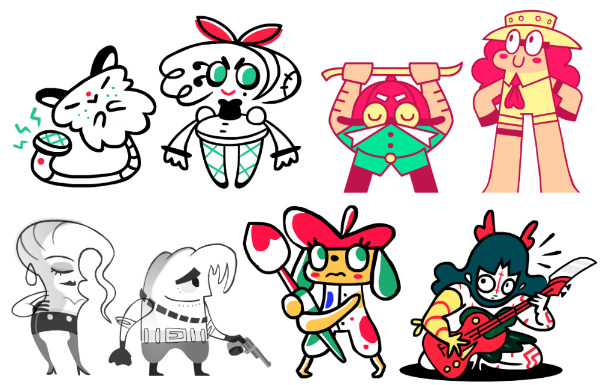 The Moomin books and the 1990 anime (I love it, some people don’t, whatever, it’s amazing) are definitely some of my most enduring childhood memories because of how weird they were! I realised a few years ago just how special Tove’s world was and started crafting my own love-letter to it all. Lempi herself begun as pretty much an homage to Jansson’s “Little My”, the ultimate precocious brat character, who is brutally honest and never holds her tongue. I feel fortunate that Lempi ended up feeling different to Little My in the final product.
The Moomin books and the 1990 anime (I love it, some people don’t, whatever, it’s amazing) are definitely some of my most enduring childhood memories because of how weird they were! I realised a few years ago just how special Tove’s world was and started crafting my own love-letter to it all. Lempi herself begun as pretty much an homage to Jansson’s “Little My”, the ultimate precocious brat character, who is brutally honest and never holds her tongue. I feel fortunate that Lempi ended up feeling different to Little My in the final product.
Other artistic influences for myself in general include Craig McCracken (Powerpuff Girls) and Genndy Tartakovsky (Samurai Jack). Their influences might seem a little strained through the Lempi filter, but they forever taught me the value of strong, simple shapes and silhouettes for characters.
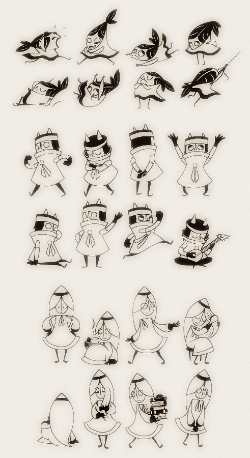 Character design is probably my favourite thing to do in general – for comics, or games, or anything. I love to work out the perfect shape each character needs to be. It’s really rewarding when you finally nail it. If I ever had to specialise in something, it’d be that.
Character design is probably my favourite thing to do in general – for comics, or games, or anything. I love to work out the perfect shape each character needs to be. It’s really rewarding when you finally nail it. If I ever had to specialise in something, it’d be that.
Last year you released the minicomic Snippets where you playfully manipulated of comics’ narrative possibilities to great effect. Could you describe the book’s central concept? And was it a conscious attempt to experiment with the unique possibilities of the medium?
Snippets‘ tagline reads: “Extracts from four comic that don’t exist.”
Each extract is only a couple of pages long, and the initial idea was to do something that wouldn’t need to have a beginning, middle and end. I wanted to make a comic that was just an experiment and not spend a month crafting a satisfying story with a set-up, conclusion, and all that boring stuff. Then I had the idea that the four extracts could be connected in some way, and eventually settled on (spoilers) having them connect to tell a single story. So I came up with 2 lead characters and designed them 4 times each. It’s kind of like an alternate-dimension type thing, where every couple of pages we swap dimensions but we’re still watching the same characters in the same narrative. It’s fun to have people start reading the comic thinking it will be four disconnected extracts and slowly realising they’re connected. That’s the main appeal of Snippets, I think.
I’d definitely like to try it again some time, it’s fun to experiment.
A double-page sequence from Snippets as it was gradually brought to life by Adam
Alongside your brother Tom you’re also one half of indie games studio SFB Games. To what degree does that side of your creative practice inform and influence your approach to comics?
The main impact of my games work is…I don’t have enough time to make comics. Making games is my job so – for now, making comics is still classified as “a hobby for when I have free time.” It’s a shame, but there we are.
Aside from that, I like to think games have helped shaped my appetite for things that are unusual, silly and creative.
My favourite games are mostly ones with weird concepts and characters. I have a growing videogame collection that contains anything strange and colourful – one prominent example is Um Jammer Lammy, a sequel to Parappa the Rapper, about a guitarist called Lammy who is a useless, nervous wreck until she picks up her guitar and then she can take on the world. It’s one of the weirdest things ever and I LOVE it. It had an influence on Snippets in particular, including one very direct reference.
If you want to see something weird, look at a video of Um Jammer Lammy – after school sale
On the Lempi side of things, sometimes I think the way Lempi solves problems by using the objects around her feels like a point-and-click adventure game, like Monkey Island. I’d love to make a Lempi adventure game one day, I already know who will play Lempi!
Actually any animated version of Lempi would be really fun.
As a newer face on the small press circuit what have been the particular challenges in finding an audience for your work over the last couple of years?
Personally I feel like the biggest challenge is my inability to devote myself to it, since my actual job is to make games. Honestly though I probably just use that as an excuse for when I don’t pursue my comics path as much as I could.
In general I’ve tried to go to comic-cons and press fairs when I can, as well as stocking Lempi comics in a few shops in the UK, and I’ve recently started selling them myself via an Etsy shop on the website. I’ve been lucky to meet lots of really great people at comic events – journalists, publishers, other artists and writers, who have been wonderful in offering help and support from time to time.
Long Lost Lempi original roughs…
For those looking to check out the work of our ‘Six UK Small Press Creators to Watch in 2015’ what festivals and fairs can we look to see you at this year?
So far I’m booked for these two:
Alternative Press Takeover 2015 (9th of May)
I’ll also do my best to get into the London MCM Comic Con in October, and maybe some others as well!
I’m also appearing at the Gosh! Comics Free Comic Book Day workshop on the 2nd May, and I’m running a comics workshop at the Greenwich Book Festival on the 22nd May!
A look at Adam’s process in a double-page spread of Long Lost Lempi as it develops…
What can we expect to see next from Adam Vian? Will there be a new issue of Long Lost Lempi in the near future? Have you any plans for comics set outside the “Lempi-verse” this year?
Hopefully Lempi #4 will be completed in the next couple of months, and then I’d love to get started on something smaller, weirder and more colourful!
I’d also like to get involved in some collections, anthologies, zines, and more community projects in general!
And, finally, the concluding question for all my ‘Six UK Small Press Creators to Watch’ – where do you hope to be by the end of 2015 in terms of your comics and their profile?
Any progress is good progress, I’d love to get my comics out to a wider audience, get some more press, maybe start printing and selling them in larger numbers somehow…perhaps there’s a way to combine my video game work with my comics work? That’s something to think about as well.
For more on Adam Vian’s Work check out his tumblr here and his website here. You can order copies of Long Lost Lempi and Snippets from his online store here. You can also follow Adam on Twitter here.
For regular updates on all things small press follow Andy Oliver on Twitter here.





